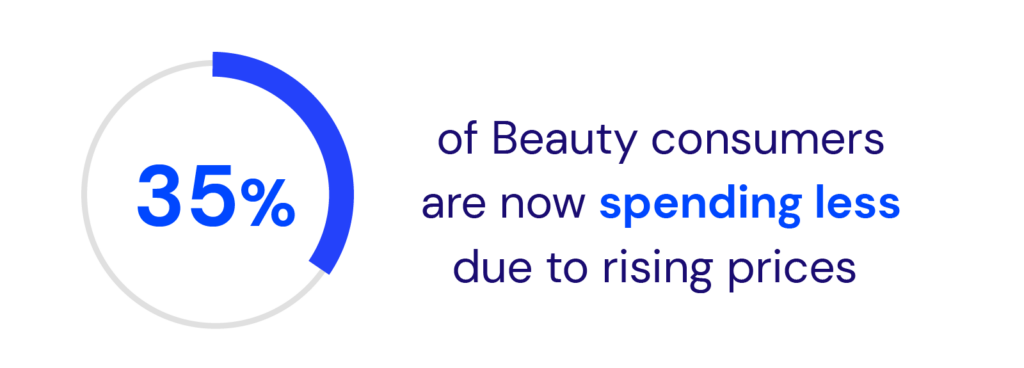How Health & Beauty Brands Can Grow Despite the Current Macroeconomic Climate

“Ecommerce continues to revolutionize the health and beauty industry, with ecommerce and social commerce sales predicted to increase as more consumers buy online in this category. From social media shopping to counterfeit product concerns, this rapidly growing market presents both opportunities and challenges for retailers and consumers alike.” – Rae Guimond – Director, Strategy & Business Development at PriceSpider
Spurred on mainly by the COVID-19 pandemic, a number of industries saw dramatic spikes in online sales. With brick-and-mortar stores closed and people told to stay indoors for months on end, the convenience of buying your favorite products online quickly took hold of customers in the Health and Beauty industry.
However, with the effects of the pandemic mostly subsiding, physical store locations reopening and inflation becoming the key concern for shoppers, global ecommerce sales growth has eased up somewhat. Forecasts now predict growth between 5-8% this year, varying slightly from region to region (eMarketer, Dec 2022).
As more consumers returned to brick-and-mortar stores worldwide, ecommerce growth decelerated, with previous growth drivers such as China and India experiencing prolonged deceleration, while Europe saw a contraction in its three largest markets: France, Germany, and the UK.

Inflation and uncertainty continue to affect consumer spending habits, particularly in the Health and Beauty industry. Under more pressure from inflationary and macroeconomic headwinds than many categories, according to a recent Statista report, 35% of Beauty consumers are now spending less due to rising prices. As consumers look to cut spending, many subscription brands see consumers cancel, suspend, or reduce their product renewals or reorders.
Ways to Attract and Keep Consumers
However, there is good news for Health and Beauty brands: there are still opportunities for brands to attract and retain customers.
The industry was a top category for new entrants into ecommerce and mobile commerce in recent years, and many of its subcategories, like anti-aging, are expected to grow over the course of the remainder of the 2020s. Brands looking to attract and keep consumers are focusing on the following to protect and grow their basket and market shares:
- The ecommerce side of the industry is rapidly eating into the traditional brick and mortar side’s share of sales. The share of online sales in the United States is predicted to hit nearly 50% by the end of the year. As a result, cosmetic and health brands are constantly entering the market.
- Some consumers are still willing to splurge on premium Beauty products they deem essential for boosting their mental and skin health.
- Health-centric products are top of mind for consumers in this category, as 45% of millennials say healthy ingredients are the single biggest influence in making a purchasing decision.
- Gen Z, one of the largest cohorts of new entrants into the ecommerce and mcommerce Health and Beauty category, are motivated in similar ways, with 46% saying healthy ingredients are the key buying consideration, 54% are influenced by brand name, and 68% are influenced most by the price.
- Shopping through untraditional avenues such as social media has become a massive trend. Social channels, influencers, and celebrity endorsements have quickly become key players in the marketing of beauty products. In fact, content creators produced 86% of the 200 highest watched videos on cosmetics on YouTube.
- Having an accurate image to show things like color and size can be the difference between conversion and returns, as 85% of shoppers say that product information and depiction are major influences in their purchase decisions.
Despite these hurdles, brands will continue striving to grow, but how can they thrive in such turbulent conditions? Being aware of the trends above is clearly valuable, but without the right tools at their disposal, there’s only so much they can do to utilize these insights.
Optimizing your share of search with Brand Monitor’s share of search module can give brands the leg up they need. Crawling thousands of sites, it tracks your product’s representation across the web, helping you keep an eye on how your product is presented, allowing you to protect your customers’ experiences with your brand.
Brand Monitor also acts as your eyes and ears on the digital shelf, helping you understand your performance on retailer and seller websites. In doing so, you can streamline the path to purchase, perfect your product content, and boost item visibility. With these insights, retailers can drive discoverability and share of search more effectively than ever before.
PriceSpider helps the world’s leading brands harness the power of customer behavior, improve search rankings, and protect their brand integrity across online storefronts. Get in touch with our experts to learn how PriceSpider can help your brand.

